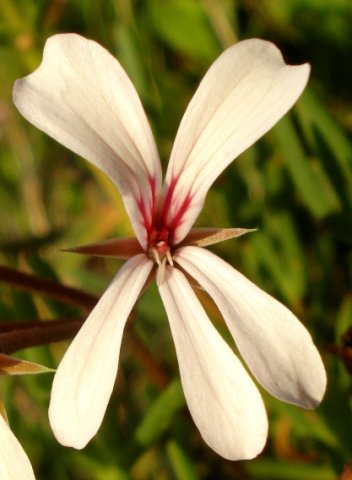Pelargonium alchemilloides flower

Author: Ivan Lätti
Photographer: Judd Kirkel Welwitch
In this Pelargonium alchemilloides flower the short white strings bending down and seldom noticed are filaments lacking anthers, staminodes. Above them the three pinkish stubs in the flower centre are anthers at the tips of their filaments. Missing from the bare white staminodes (sterile stamens) below. Pelargonium flowers are endowed with ten filaments of which two to seven bear anthers, enough for propagation purposes.
The nectar of a Pelargonium flower is a detail often passing people by. It is produced by a gland in the calyx and stored in a hollow spur at the back of the upper sepal, on top of the pedicel or flower stalk.
Close scrutiny and image enlargement disclose secrets of natural phenomena, seldom all, but continually introducing new frontiers. There is a nanoworld of molecules and atoms and subatomic particle worlds to keep people constructively and destructively busy, also concerning plants. Observers of flowers may not need to delve into all the depths of the scientific world, even the real world. Science ventures below and above the scale of the humanly experienced reality in bigger and smaller target areas for all kinds of quests. As understanding expands the borders of reality, more footholds are found for searching further. The ordinary mortal does not need to be cut off from all this excitement.
Curiosity is a gift, a driver and a risk; the world is everybody's to tackle. Occasionally the search may be hazardous, but there's no chance of killing curiosity in the species. The ebbs and flows of investigation and contemplation match times of celebration and capitalising on achievement. Big and small steps of breakthrough form the beacons on the road of human endeavour. Becoming part is possible in our time (Manning, 2009; Stoneman,1928; Wikipedia).

